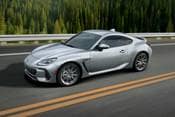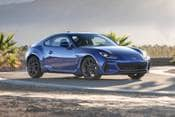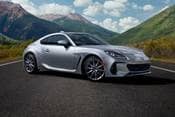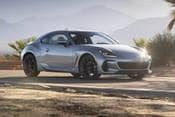Opening the BRZ's aluminum hood reveals the biggest and most desired improvement to the little Subaru. Replacing the previous 2.0-liter engine is a 2.4-liter flat-four making 228 horsepower and 184 lb-ft, an increase of 23 hp and 28 lb-ft over the previous model. This engine — based on the 2.4-liter engine used in the Subaru Ascent, but without the turbocharger — is smoother, sounds better and delivers a much more satisfying midrange punch of power than the old motor.
Our time in the BRZ, on both road and road course, highlighted the improvements of the new engine. The added power is available throughout the rev range, making it more enjoyable than before to drive the BRZ around town. Additionally, the smoothness of the engine and linear nature of the power delivery make it more fun on a racetrack or a good road. We're less enamored with the electronically enhanced engine noise that's pumped in through the speakers, but the 2.4-liter still sounds better than the previous engine. In short, the engine improvements alone are worth the upgrade to the 2022 model year.
Power goes to the rear wheels through either a six-speed manual transmission or a six-speed automatic. Subtle changes have been made internally to the six-speed manual to make shifting a touch more intuitive, while the automatic has a new Sport mode that can rev-match on downshifts. We spent plenty of time with both transmissions and, while we still prefer the somewhat notchy six-speed manual to the automatic, the automatic does a good job of managing things, even on a racetrack. Thanks to sensors, the automatic knows when you're in the middle of a turn and holds off on shifting so as not to upset the balance of the car.
The BRZ is slightly heavier with the new 2.4-liter engine, but this is still a featherweight car. According to Subaru, a manual-equipped BRZ should start with a curb weight of just 2,815 pounds. That's heavier than a Mazda Miata (around 2,350 pounds) but way less than a four-cylinder Ford Mustang (more than 3,500 pounds). A stiffer body structure and larger engine have added a few pounds, but Subaru managed to minimize the weight gain with increased use of aluminum in body panels and suspension components.
For 2022, Subaru has worked to fine-tune the BRZ's handling, its best attribute, in some straightforward ways as well as some more involved. More basic changes, like new lightweight aluminum suspension bits and a change in the way the rear sway bar is mounted, enhance both responsiveness and stability. But Subaru has gone so far as to move the front seats closer together to improve the polar moment of inertia, otherwise known as the vehicle's ability to rotate. It's not enough of a difference that occupants will notice they're sitting any closer, but Subaru is adamant that the change is effective.
As we did with the more powerful engine, we experienced Subaru's changes to the BRZ's handling immediately. Over bumpy country roads, the BRZ remained straight and stable, a testament to the added stability. The steering was still direct but managed to not be darty or overly affected by the crown (aka high point) or slope of the road. On both a racetrack and an autocross course, the BRZ felt alive and on its toes. We were able to get the BRZ to change direction with steering, throttle or braking inputs, but always with confidence-inspiring predictability. This car remains a blast for both the novice and the seasoned driver.
Another change of note is the option of a more aggressive performance tire for the BRZ. Available on the Premium trim is the impressive Michelin Pilot Sport 4S that, incidentally, is also the standard tire on the monstrous Ford Shelby GT500. These summer performance tires give the BRZ loads more grip than the standard rubber and allow a more experienced driver to really maximize the capabilities of the BRZ. But that's not to say the standard tires aren't a lot of fun too. The BRZ exhibits excellent balance and quick reflexes, which makes it a riot to toss around when conditions allow. Because sometimes low grip is fun too.









